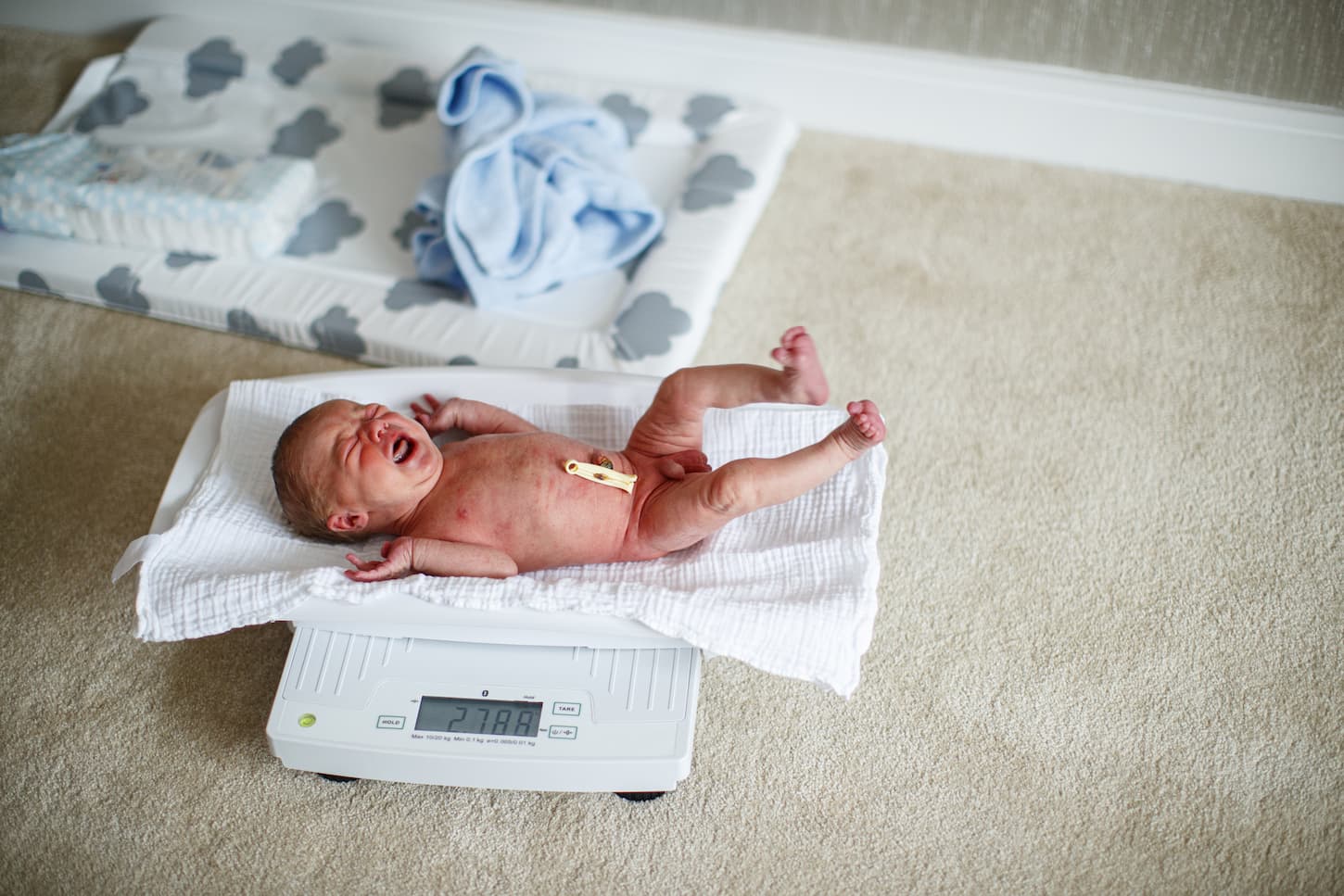As parents, we have to make some hard decisions about what’s best for our baby’s welfare. These days, there’s a wealth of information about baby care available, but the advice of experts isn’t always consistent. Especially when it comes to the hot topic of how long it’s okay to let a baby cry.
If a newborn baby is crying, pick them up within a few minutes. However, if sleep training an older baby, as long as they don’t have urgent needs such as feeding, they can be left to cry for up to 2 hours before picking them up.
There’s a big difference in the amount of time a baby can be left to cry depending on their age and development. So, if you want to know exactly how long it’s ok to let a baby cry, take a look at this vital information below.

How Long To Let Baby Cry Before Picking Up?
If a baby cries because they need a diaper change, feeding, or comfort, they should always be picked up and tended to. However, from 3 or 4 months old, babies can self-soothe. After this age, they don’t need to be picked up unless they have an urgent need.
In the first few weeks, newborn babies cry a lot. On average, in the first six weeks, a baby will cry for between 2 and 3 hours a day. Usually, newborns cry for a valid reason, such as feeding, diaper change, or comfort, so don’t leave them crying for more than a few minutes.
The world is a strange new environment for babies, and crying is the only way they know how to get your attention. Close contact with parents and family is vital for a newborn baby’s development because it makes them feel safe and secure.
When babies are around 3 or 4 months old, most can self-soothe. Self-soothing is when a baby can soothe themselves to sleep without any assistance. However, this is a technique they have to learn, and for most babies, this comes with a lot of tears.
As distressing as it might seem, it will not harm a baby if you let them cry it out for short periods, as long as they’re not crying for a legitimate reason such as hunger or illness.
It’s good for both of you to gain some independence, and self-soothing is a major milestone in a baby’s development.
When a baby cries alone to learn how to self-soothe, this is also known as controlled crying or cry it out.
How Long Should You Let a Baby Cry it Out?
Don’t newborn babies cry it out, because they can’t self-soothe – pick them up as soon as possible if they’re crying. From 3 or 4 months old, as long as the baby isn’t crying because of an urgent need, they can be left to cry for up to 2 or 3 hours.
Some parents aren’t comfortable leaving their baby crying for 20 minutes, let alone two hours. However, most of the evidence suggests that once they’re developed enough, leaving a baby crying won’t have a negative long-term impact on their psychological and emotional development.
One study (source) found that babies produce the stress hormone cortisol when they are left to cry, but it didn’t have any long-term, negative health implications.
Just because babies can cry it out for two hours doesn’t always mean they should. Pick your baby up and comfort them if they vomit due to stress, or poop from the strain of crying.
If the crying makes you crazy listening to it, pick the baby up and comfort them – your welfare is important too.
If a baby’s crying suddenly changes during cry it out, re-check their needs. Something might have changed in their environment. If worried that the baby is crying due to pain or illness, always get advice from a physician.
To get a better idea about when to pick a crying baby up, learn to distinguish between the different cries. Work out which cry means stress or discomfort and which are a vie for attention.
After learning the different types of cries, you’ll know how to prioritize time if there are other children and two are crying. Attend to the one with the most pressing need first.
What is the Cry It Out Method of Sleep Training?
Cry it out (COI) is a quick and effective sleep training method that can work in under a week. However, it’s not for the faint-hearted because you might have to listen to your baby crying intensely for several hours a night.
Most babies aren’t ready to start sleep training until they’re around 5 or 6 months old, depending on their development. Always check with the pediatrician for advice before starting sleep training.
During CIO sleep training, it will take most babies between 20 minutes and two hours to cry themselves to sleep. In rare cases, babies may cry for 3 hours solid! Each baby is different, and they will often cry for varying lengths of time each night too.
As a general rule, the first night is one of the worst, but potentially days 3 and 5 can be pretty bad too. After day 5, most babies seem to settle much more easily.
With the CIO method, put the baby to bed and let them cry themselves to sleep. However, there are different levels of CIO and we’ll look at these below. With this information, you can choose the method that seems most fitting for your baby.
Step #1 – Full extinction
Full extinction is going out of the room after putting the baby down for bed and letting your baby cry themselves to sleep without giving them any physical comfort or soothing.
With full extinction, the baby still needs to be monitored, but keep physical contact to a minimum unless they have an urgent need. You can tell if your baby has an urgent need because the cry might change into a distressed shriek.
Step #2 – Gradual extinction
With gradual extinction, make regular, timed checks on the baby Instead of leaving the baby to cry uninterrupted until they fall asleep. Many parents go in at 10, 20, or 30-minute intervals to check on their babies and let them know they’re there, but they don’t give them any physical comfort.
The benefit of gradual extinction is that the baby will find it comforting knowing that you’re there. However, your presence might stimulate them and it will often make your baby take even longer to cry themselves to sleep.
Step #3 – Faded extinction
Faded extinction means checking the baby at regular intervals, but gradually increasing the time between checks as the night goes on. So, for example, you could check on them after 10 minutes, then after another 20 minutes, then again 30 minutes later.
Step #4 – Controlled crying
Controlled crying is when parents let their babies cry for a set amount of time, for maybe 15 minutes. After 15 minutes, they pick their baby up and give them comfort, and then return them to the crib for another 15 minutes of controlled crying.
Cry it out is a safe and effective sleep training method for most babies. However, if you or your baby can’t seem to adapt to any of the above CIO methods, consider switching to a no-cry sleep training method.

What Are Alternative Sleep Training Methods to Cry It Out?
Cry it out sleep training doesn’t suit all babies or parents. The alternative to this is no-cry sleep training methods such as the chair method or fading out. No-cry sleep training has minimum tears, however, most of the time, they take much longer to have an effect.
Ultimately, the amount of time spent on sleep training will depend on your baby. Some babies take to sleep training easily, while others need constant support and guidance. With no-cry sleep training, you make gradual changes to your baby’s sleeping habits, so it causes less stress and tears.
Below, we’ll take a closer look at four different methods of no-cry sleep training.
Step #1 – The chair
With the chair method, put the baby to bed and stay next to their crib, sitting on a chair. When your baby cries, offer them comfort and support. This comfort could be physical or just by using a soothing voice.
Each evening, move the chair a little bit further away from the crib, towards the bedroom door. After a few weeks, you should be able to put your baby down and leave the room.
Step #2 – Fading out
Fading out is gradually fading out negative sleep associations such as rocking and feeding and replacing them with positive ones. Positive sleep associations do not require physical parental contact. Positive sleep associations are environmental ones, such as a calm, dark, soothing environment.
Step #3 – Pick up and put down
If your baby starts crying with this method, pick them up immediately and give them lots of comforts. Once the baby is settled and drowsy again, put them back in their crib. Each time the baby starts crying, repeat the process.
Step #4 – Focus on the bedtime routine
Bedtime routines are one of the most vital aspects of sleep training, and some parents can sleep train their babies with a strong focus on their bedtime routine alone. If you make bedtime a calm and relaxing experience, this might be enough to get the baby into a good sleeping routine.
How Long Should You Let a Newborn Cry?
Don’t let newborn or swaddled babies cry for more than a few minutes. Newborns usually cry for a good reason. Unlike older babies, leaving younger or swaddled babies to cry for a long time can be dangerous and bad for their health, emotional development, and well-being.
Newborn babies need lots of cuddles and attention to make them feel secure. So even if the newborn is fed, clean and in good health, you should still pick them up if they’re crying. Sometimes, they just need to feel close to you.
Never leave swaddled babies to cry it out because swaddling can become a potential hazard. Swaddling can come loose on a crying baby, and the baby can’t free their hands and remove obstructions from their mouth.
Furthermore, a swaddled baby might roll onto their stomach and not be able to get back around again.
Is It OK To Let A Newborn Cry for 5 Minutes?
Newborn babies cry a lot, and you might find yourself exhausted attending to every cry like a dutiful parent. While it’s important to pick newborn babies up when they cry, leaving them 5 minutes won’t hurt them.
It’s better to leave a baby crying for 5 minutes if you feel stressed out or exhausted. If the baby’s crying irritates you, it’s much better to wait a few minutes and take some deep breaths before picking them up. The welfare of the parent is important too.
Furthermore, if you’re stressed when you pick your baby up, this could make them cry even more.
Can You Let a Baby Cry It Out At One Month Old?
Don’t leave one-month-old babies to cry it out because they’re still too young, and they’re not ready to start sleep training. However, from 6 weeks old, in some cases, it’s ok to let a baby cry.
Between 5 and 12 weeks old, for some unknown reason, some babies will have a crying fit in the evening. If your baby is clean, fed, and has no pressing needs, it’s ok to let them cry, even in another room if their unreasonable crying is too much for you to bear.
During a crying fit, make sure your baby is in a safe place, not swaddled, and check them regularly to make sure they’re ok.
How Long Can You Leave a 1-Year-Old to Cry?
It’s okay to leave a one-year-old to cry it out for as long as a younger baby would – up to two or three hours. However, the cry-it-out method isn’t as effective on children older than 12 months old.
It’s never too late for sleep training, and there’s no reason why CIO won’t work on a one-year-old. Even if your one-year-old is fully sleep trained, you might still find yourself facing a sleep regression at some point. Cry it out might take more patience, time, and effort with older children.
Children aged one and above are much more independent and mobile than younger babies. As a result, it might be hard to get a one-year-old to stay in their bed if you leave them to cry for too long.
If your one-year-old keeps vomiting, pooping or escaping, or there are no results after a week, try another sleep training method instead. Don’t be afraid to use a selection of different sleep training methods. It’s good to be flexible, especially with older children.
Want to know more about letting a toddler cry? Read our article, Is It OK to Let a 1-Year-Old Cry It Out?
How Long to Let Baby Cry it Out For Naps?
At nap time, it’s okay to leave babies older than four months to cry it out with no intervention, if they are checked at regular intervals. However, day sleep cycles are different from night ones, so don’t let the baby cry it out for more than an hour during the day.
At nap time, put the baby down 15 minutes before their usual time. If your baby doesn’t fall asleep after 15 minutes, keep checking them from a distance – try not to go back in. If they don’t sleep after an hour, pick them up, feed and comfort them, and try with the nap again later.
Don’t let a baby fall asleep outside the crib. If they get sleepy, put them straight back in their bed to fall asleep.
Best Products For Crying Babies
Getting a baby to stop crying can be as easy as picking them up, hugging them, and using the 5 S’s. Or it can be way more complicated, depending on the situation. Here are some products that can help either way.
Use the 5 S’s
- Swaddle your baby with some muslin swaddle blankets (like these on Amazon).
- Shush your baby with a white noise machine (here’s a new brand that looks intriguing on Amazon), although if you want my favorite white noise machine, it’s this one.
- Swing your baby from your arms, or with a swing. My kids liked being held more!
- Use a side or stomach position, but always lay them down on their back to sleep.
- Suck it up, buttercup! Let your baby suck on a pacifier, bottle, or nurse.
Make checking in on your baby easier.
- Use a video monitor (like this one with sound on Amazon).
- Don’t turn on all the lights! Use a night light instead. This one, on Amazon, uses a touch sensor which is awesome.

Key Takeaways and Next Steps
If your baby is crying, always make sure they don’t have any urgent needs such as feeding, illness, or a diaper change. Don’t leave newborns for more than 5 minutes crying. Newborn babies need lots of warmth, comfort, and attention to help them feel secure.
At 3 or 4 months old, babies can self-soothe, which means you can leave them crying for longer. During sleep training, some babies can cry it out for up to two hours. However, never leave a baby to cry it out if they’re ill. Your baby’s welfare is more important than sleep training.
When learning about parenting or sleep training techniques, it’s important to learn from a wide variety of reputable sources. These are the sources used in this article and in our research to be more informed as parents.
Are you sleep training right now? Make sure you know how long to let your child cry (or not) before picking them up by reading this article next: How Long Does It Take A Baby To Cry Themselves To Sleep?
Resources
Learning about parenting or sleep training techniques is important to learn from various reputable sources. These are the sources used in this article and our research to be more informed as parents.
- Cherney, Kristeen. “Should You Let Your Child Cry It Out During Naps?” Healthline, 25 Apr. 2019, www.healthline.com/health/parenting/cry-it-out-naps.
- “Crying Baby: What to Do When Your Newborn Cries.” Mayo Clinic, 25 Feb. 2022, www.mayoclinic.org/healthy-lifestyle/infant-and-toddler-health/in-depth/healthy-baby/art-20043859?reDate=01032022.
- Etherton, Hayley, et al. “Discussion of Extinction-Based Behavioral Sleep Interventions for Young Children and Reasons Why Parents May Find Them Difficult.” Journal of Clinical Sleep Medicine, vol. 12, no. 11, 2016, pp. 1535–43. Crossref, doi:10.5664/jcsm.6284.
- Gradisar, Michael, et al. “Behavioral Interventions for Infant Sleep Problems: A Randomized Controlled Trial.” American Academy of Pediatrics, 1 June 2016, publications.aap.org/pediatrics/article-abstract/137/6/e20151486/52401/Behavioral-Interventions-for-Infant-Sleep-Problems?redirectedFrom=fulltext.
- Higley, Elizabeth, and Mary Dozier. “Nighttime Maternal Responsiveness and Infant Attachment at One Year.” Attachment & Human Development, vol. 11, no. 4, 2009, pp. 347–63. Crossref, doi:10.1080/14616730903016979.
- Marcin, Ashley. “Everything You Need to Know About the Cry It Out Method.” Healthline, 24 June 2020, www.healthline.com/health/baby/cry-it-out-method.
- Mileva-Seitz, Viara R., et al. “ASSOCIATION BETWEEN INFANT NIGHTTIME-SLEEP LOCATION AND ATTACHMENT SECURITY: NO EASY VERDICT.” Infant Mental Health Journal, vol. 37, no. 1, 2015, pp. 5–16. Crossref, doi:10.1002/imhj.21547.
